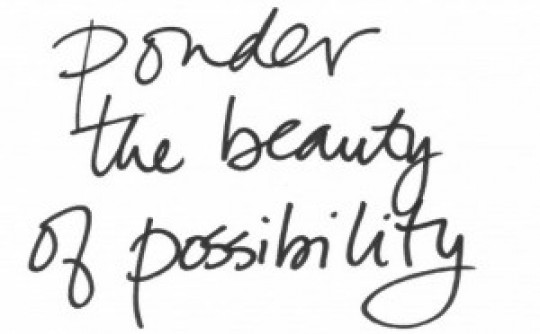The Art of Possibility
13 Mar 2013

Part 2: The Royal Exchange Theatre ‘Family Experience Programme’
This is Part 2 of a series of 3 blogs looking at the value of Audience Experience Design using a case study at the Royal Exchange Theatre (RXT) in Manchester. If you want to get up to speed, please click here for Part 1: Focusing on the Blind Spot.
For the rest of you, welcome back.
I’ve called Part 2 ‘The Art of Possibility’ because one of the biggest challenges I encounter when working with mainstream, building-based arts organisations is individual and group thinking that has become stuck. Whilst there may be plenty of creative, imaginative input into what goes on stage, many other areas of the audience experience offer has improved incrementally at best – and most often remains unconsidered. Moreover, employees (who are custodians of the theatre) satisfy themselves with managing and maintaining the status quo because that is the path of least resistance.
The capacity to re-imagine, experiment and take risk beyond the limits of the stage has been undermined by the many economic, managerial, policy and societal challenges facing the arts today. We need to re-acquaint ourselves with the art of possibility for its own sake, regardless of do-ability. Without imagination and disruptive thinking to keep our offer fresh, appealing and relevant we run the risk of being blindsided by other sectors that do.
So … back to the programme.
Having reached the point of developing a Family Experience Plan, with clear, aspirational objectives, we needed to undergo four specific processes (based on the principles of Design Thinking) to realise the plan:
1: Optimise what we already have.
2: Innovate and create new platforms for value delivery.
3: Prototype, test, refine and deliver.
4: Evaluate and learn.
1. Optimise what we already have
Customer Journey Mapping revealed areas of mediocre performance (satisfaction points), unacceptable performance (pain points) and ‘hugs’ (delight points). All of these needed optimising. Ideas included:
Queue busting: more service points for buying refreshments, a safe place for families to relax whilst one family member became the ‘go-for’ and a walking sweet shop that approached customers rather than expecting them to queue at a static sales point.
Safety and security: a policy where no child is allowed to exit the building unaccompanied, and a dedicated meet up point for lost children.
Welcome: a personal greeting and goodbye at entrances, security guards dressed in friendlier uniforms and character hand puppets for ushers to welcome and interact with children.
Affordability and value-for-money: more varied catering options at different price points together with free activities.
2: Innovate and create new platforms for value delivery
Having optimised the existing offer, we needed to push performance further and think beyond the easy and the obvious. The team needed to cross over into new territory and create additional value, and so I facilitated them through a process of Creative Idea Generation designed to stimulate fresh thinking in answer to the question: In what ways might we deliver on our Family Experience Plan?. This session combined creative thinking games and classic brainstorming with SCAMPER techniques (http://www.mindtools.com/pages/article/newCT_02.htm) in order to unstick the team’s thinking. Over 150 ideas flowed out from this session which were clustered, evaluated and voted on until we landed on the following 7:
Prop Shop: a place where families can creatively experience what really happens in a producing theatre,
Wardrobe: where families can have fun dressing up, creating and playing characters, again referencing 'theatricality',
Scene settings: a series of changeable backdrops where children can role play and act out in costume, more theatricality,
Make a Play: a simple set of dialogue sheets children can mix and match to act out stories, even more theatricality,
Rat’s Lair: a chill out zone where families can relax away from the pre-show Front of House busy-ness,
Family Welcome Trail: a dedicated route where families can discover the building’s unique architecture and history,
Food Emporium: a beautifully designed food service area to help the queue-busting effort and complement the overall brand experience.
These are what I refer to as new service delivery and audience enrichment platforms. These particular ideas provide opportunities for families to experience ‘aliveness’, ‘pleasure’, and ‘creativity’.
The planned interventions also created a unique sense of Brand RXT. Making props, trying on costumes and role playing would connect audiences more fully with the ethos of this creative, artistic, producing theatre. The unique beauty and history of the building would be experienced more fully, directly and intimately via the family trail. Moreover, audiences would also encounter the thrill of discovering which famous faces had ‘trodden the boards’.
Advance marketing would encourage families to arrive earlier, play longer and thus potentially be willing to spend more. The concept of ‘memory making’ was also adopted: creating opportunities for families to take photos of themselves to keep and share with others via social media, thus augmenting awareness of the show and the amplified experience offer.
Then came more ‘fun’ as the team brought their ideas alive. Visual thinking, group dialogue, team challenges, Play Dough modeling and even Snoopy figurines populated a 'design playground' where the team could creatively develop the customer story. Paper prototypes were made and pitched to members of the Creative and Senior Management Team. Winning ideas were selected and a budget was assigned. Given the time and modest budget available for what was to be a pilot project we had to cut the cloth to fit. That was probably one of the biggest challenges of the whole project given the quality and breadth of the team’s aspirations.
What happened next? Part 3 will follow soon with details of Steps 3 and 4 - what was tested, what was delivered - together with an overview of what we achieved and the value of this approach.
Click here if you'd like to see images from the creative and prototyping worshops.